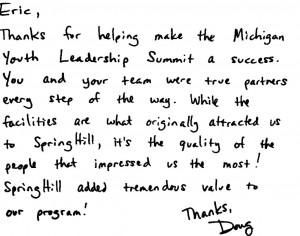Last week I got this thank-you note:
“Thanks for helping make our retreat a success. You and your team were true partners every step of the way. While the facilities are what originally attracted us to SpringHill, it’s the quality of the people that impressed us the most! SpringHill added tremendous value to our program! Thanks, Doug.”
 This is the kind of response we’ve been getting from guests since my original training on Say Yes! to the Guest several months ago. I even had one guest approach me and say curiously, “No one here ever says the word no.” Perfect!
This is the kind of response we’ve been getting from guests since my original training on Say Yes! to the Guest several months ago. I even had one guest approach me and say curiously, “No one here ever says the word no.” Perfect!
The reality is, to provide great guest service, saying Yes! is more than just what we say, it also comes through in our attitudes and postures. So here are three ways to say Yes! with our body language and attitudes.
Say, “Yes, I’m approachable.”
I addressed several of these postures in my previous post You are Welcome to Smile. Each of these says to the people you are serving that they can approach you with a question, need or concern. The goal is for people to feel comfortable walking right up to you, confident that you work here (they don’t have to ask you if you do), and free to ask whatever is on their mind without waiting.
- Maintain an open posture. Stand with your shoulders back and your hands at your sides or behind your back. Putting your hands in your pockets or folding them across your chest make you look closed-off to conversation.
- Stand shoulder-to-shoulder with other staff, not face-to-face. Standing face-to-face with a person shows them and others that that person has your complete attention. When you do this, other guests will avoid you, assuming you’re talking about something far too important to interrupt. When you stand side-by-side, it frees you up to scan your guests for people who need assistance, and allows you to halt the conversation when someone begins to approach you and greet them.
- Smile. Smiling takes practice, and for many of us it’s not the natural state. Practice smiling while you work, wait and greet. It says a lot.
- Wear your name badge in a visible place. Your name badge gives people confidence that you can help, reassures them of your name, and takes away the awkward pressure for them of trying to remember it while they ask their question. It just makes everyone more comfortable.
Say, “Yes, I want to help.”
The contrast here is to saying, “Yes, I can help.” Guests and customers don’t want to be a bother or burden, but they may enjoy the brief conversation they have with you while you assist them if you convey that you are not only able, but happy to help.
- Anticipate needs. Don’t wait for people to approach you for help. Approach them first, looking for people who are studying maps and schedules, or who seem to be looking for someone or something.
- Introduce yourself first. Say, “Hi, I’m Eric,” and extend your hand. It makes it personal. They will almost always respond by offering their name too. It makes the whole interaction feel more like a greeting and less like an interrogation (for instance, if you approach someone and ask their name).
- Ask how you can help, not if you can. Say, “How can I help you?” or “Are you being helped yet?” If you simply ask if you can, a guest may respond with a no not wanting to be a bother. These questions allow you to be of service regardless how they respond.
Say, “Yes, I love working here.”
- What’s your NPS? We use the Net Promoter Score (NPS) to measure the level of satisfaction our guests have with the experience they are having at camp. Businesses all around the world use the same measure, arrived at by asking this one simple question: On a scale of 0 to 10, with 0 being not a chance and 10 being in a heartbeat, how likely would you be to refer a friend to SpringHill? I’m suggestion we should ask the same question of ourselves. Do I love my job enough that I would recommend working here to a friend? If I do, I should act like it. If I don’t, I need to take some action to correct the situation or find a company that is a better fit for me.
- Be part of the team. See some trash on the ground? Pick it up, even if it’s technically not your job. See a guest that needs help? Offer to help, even if you’re on your way to do something else. Encourage others. Offer solutions. Help your co-workers be successful. This all shows to your guests.
- Say we and our instead of they and their. Act and speak like you own the place, and are proud of it. We can do that. It would be our pleasure. We’re happy to serve.
Great article! Being approachable and willing to help makes such a big difference! I especially loved the point you made about body stance when talking with other team members. I hadn’t heard it before, but plan to use it!
🙂
Thanks, Christy. Glad you found something you can use!